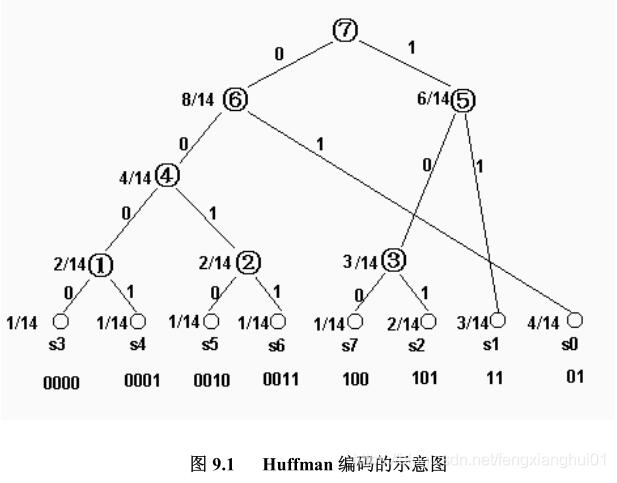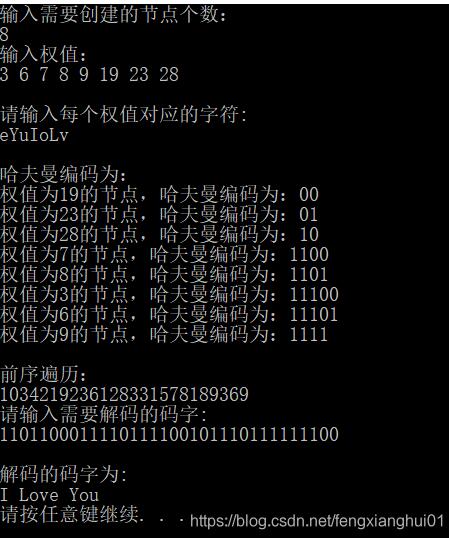哈夫曼(Huffman)编码是一种常用的压缩编码方法,是 Huffman 于 1952 年为压缩文本文件建立的。它的基本原理是频繁使用的数据用较短的代码代替,较少使用的数据用较长的代码代替,每个数据的代码各不相同。这些代码都是二进制码,且码的长度是可变的。
下面给出具体的 Huffman 编码算法:
(1) 首先统计出每个符号出现的频率,上例 S0 到 S7 的出现频率分别为 4/14,3/14,2/14,1/14,1/14,1/14,1/14,1/14。
(2) 从左到右把上述频率按从小到大的顺序排列。
(3) 每一次选出最小的两个值,作为二叉树的两个叶子节点,将和作为它们的根节点,这两个叶子节点不再参与比较,新的根节点参与比较。
(4) 重复(3),直到最后得到和为 1 的根节点。
(5) 将形成的二叉树的左节点标 0,右节点标 1。把从最上面的根节点到最下面的叶子节点途中遇到的 0,1 序列串起来,就得到了各个符号的编码。

产生 Huffman 编码需要对原始数据扫描两遍。第一遍扫描要精确地统计出原始数据中,每个值出现的频率,第二遍是建立 Huffman 树并进行编码。由于需要建立二叉树并遍历二叉树生成编码,因此数据压缩和还原速度都较慢,但简单有效,因而得到广泛的应用。
第一步:实现哈夫曼编码与解码
|
1
2
3
4
5
6
7
8
9
10
11
12
13
14
15
16
17
18
19
20
21
22
23
24
25
26
27
28
29
30
31
32
33
34
35
36
37
38
39
40
41
42
43
44
45
46
47
48
49
50
51
52
53
54
55
56
57
58
59
60
61
62
63
64
65
66
67
68
69
70
71
72
73
74
75
76
77
78
79
80
81
82
83
84
85
86
87
88
89
90
91
92
93
94
95
96
97
98
99
100
101
102
103
104
105
106
107
108
109
110
111
112
113
114
115
116
117
118
119
120
121
122
123
124
125
126
127
128
129
130
131
132
133
134
135
136
137
138
139
140
141
142
143
144
145
146
147
148
149
150
151
152
153
154
155
156
157
158
159
160
161
162
163
164
165
166
167
168
169
170
171
172
173
174
175
176
|
#include <stdio.h>#include <malloc.h>#include <stdlib.h>#include <string.h> // 结构体typedef struct Tree{ int weight; // 权值 int id; // 后面解码用到 struct Tree * lchild; // 左孩子 struct Tree * rchild; // 右孩子}TreeNode; // 创建哈夫曼树TreeNode* createTree(int *arr, int n){ int i, j; TreeNode **temp, *hufmTree; temp = (TreeNode**)malloc(sizeof(TreeNode*)*n); // 创建结构体指针数组 for (i = 0; i < n; ++i) { temp[i] = (TreeNode*)malloc(sizeof(TreeNode)); temp[i]->weight = arr[i]; temp[i]->lchild = temp[i]->rchild = NULL; temp[i]->id = i; } for (i = 0; i < n - 1; ++i) { int small1 = -1, small2; // 存储最小权值的两个节点 for (j = 0; j < n; ++j) // 第一步:找到最开始两个非空节点 { if (temp[j] != NULL && small1 == -1) { small1 = j; continue; } if (temp[j] != NULL) { small2 = j; break; } } for (j = small2; j < n; ++j) // 找到权值最小的两个节点,并将最小的序号赋给small1,次小的赋给small2 { if (temp[j] != NULL) { if (temp[j]->weight < temp[small1]->weight) { small2 = small1; small1 = j; } else if (temp[j]->weight < temp[small2]->weight) { small2 = j; } } } hufmTree = (TreeNode*)malloc(sizeof(TreeNode)); hufmTree->lchild = temp[small1]; hufmTree->rchild = temp[small2]; hufmTree->weight = temp[small1]->weight + temp[small2]->weight; temp[small1] = hufmTree; temp[small2] = NULL; } free(temp); return hufmTree;} // 前序遍历void PreOrderTraversal(TreeNode* hufmTree){ if (hufmTree) { printf("%d", hufmTree->weight); PreOrderTraversal(hufmTree->lchild); PreOrderTraversal(hufmTree->rchild); }} // 哈夫曼编码void hufmTreeCode(TreeNode* hufmTree,int depth){ static int code[10],i; if (hufmTree) { if (hufmTree->lchild == NULL && hufmTree->rchild == NULL) { int i=0; printf("权值为%d的节点,哈夫曼编码为:", hufmTree->weight); for (i = 0; i < depth; ++i) { printf("%d", code[i]); } printf("\n"); } else { code[depth] = 0; hufmTreeCode(hufmTree->lchild, depth + 1); code[depth] = 1; hufmTreeCode(hufmTree->rchild, depth + 1); } }} // 哈夫曼解码// 思想:通过定位ID,找到源码中的位置void hufmTreeDecode(TreeNode* hufmTree, char a[],char st[]){ int i,arr[100]; TreeNode* temp; for (i = 0; i < strlen(a); ++i) // 转化字符串编码为数组编码 { if (a[i] == '0') arr[i] = 0; else arr[i] = 1; } i = 0; while (i < strlen(a)) { temp = hufmTree; while (temp->lchild != NULL && temp->rchild != NULL) { if (arr[i] == 0) temp = temp->lchild; else temp = temp->rchild; i++; } printf("%c", st[temp->id]); } printf("\n"); free(temp);} int main(){ int i, n, arr[100]; printf("输入需要创建的节点个数:\n"); scanf("%d", &n); printf("输入权值:\n"); for (i = 0; i < n; ++i) scanf("%d", &arr[i]); printf("\n请输入每个权值对应的字符:\n"); char st[100]; scanf("%s",st); // 创建哈夫曼树 TreeNode* hufmTree; hufmTree = createTree(arr, n); // 哈夫曼编码 printf("\n哈夫曼编码为:\n"); hufmTreeCode(hufmTree, 0); // 遍历 printf("\n前序遍历:\n"); PreOrderTraversal(hufmTree); // 解码 printf("\n请输入需要解码的码字:\n"); char codeSt[100]; scanf("%s",codeSt); printf("\n解码的码字为:\n"); hufmTreeDecode(hufmTree, codeSt, st); free(hufmTree); system("pause"); return 0;} |

以上就是本文的全部内容,希望对大家的学习有所帮助,也希望大家多多支持服务器之家。
原文链接:https://blog.csdn.net/fengxianghui01/article/details/85253486














